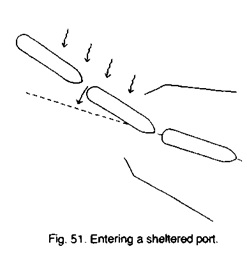Effect of Wind and Current
Whereas the effect of wind on the ship has to be considered with respect to the pivot point, current affects a freely moving ship as a whole and consequently its effect is on the center of gravity. However, when we try to keep the ship stationary relative to the ground, we must arrest the ship’s movement and let the ship make speed through the water contrary to the current, in which case the ship meets underwater resistance.
All freely moving ships, not being subjected to wind and dead in the water, have the same speed as the current, whether the ships are big or small, loaded or light. Ships not freely moving, as ships at anchor or moored, are subjected to pressure exerted by the current, pressure which is directly proportionate to the exposed underwater area and to the square of the current velocity.
In a strong tide we see that ships at anchor, or moored to a single point, are heading into the tide; when it is nearly slack water ballasted ships will be more affected by wind while the loaded tankers still remain heading into the tide. 
However, the heading of the ballasted ship, after having been tied up to the buoy, may be quite different from the heading of the loaded ship (fig. 31).


Leave a Comment